At CNN, I spent 18 months building a new streaming service, an ambitious $300 million dollar bet on the company’s future. CNN+ arrived on March 29, 2022.
As you may have heard, our efforts were not long for this world, and CNN+ failed to last even one full month. The news reached me almost immediately, as my phone started to go off in the recovery room at Cedars-Sinai Medical Center, where my wife had given birth less than 12 hours earlier. It was my first day of parental leave.
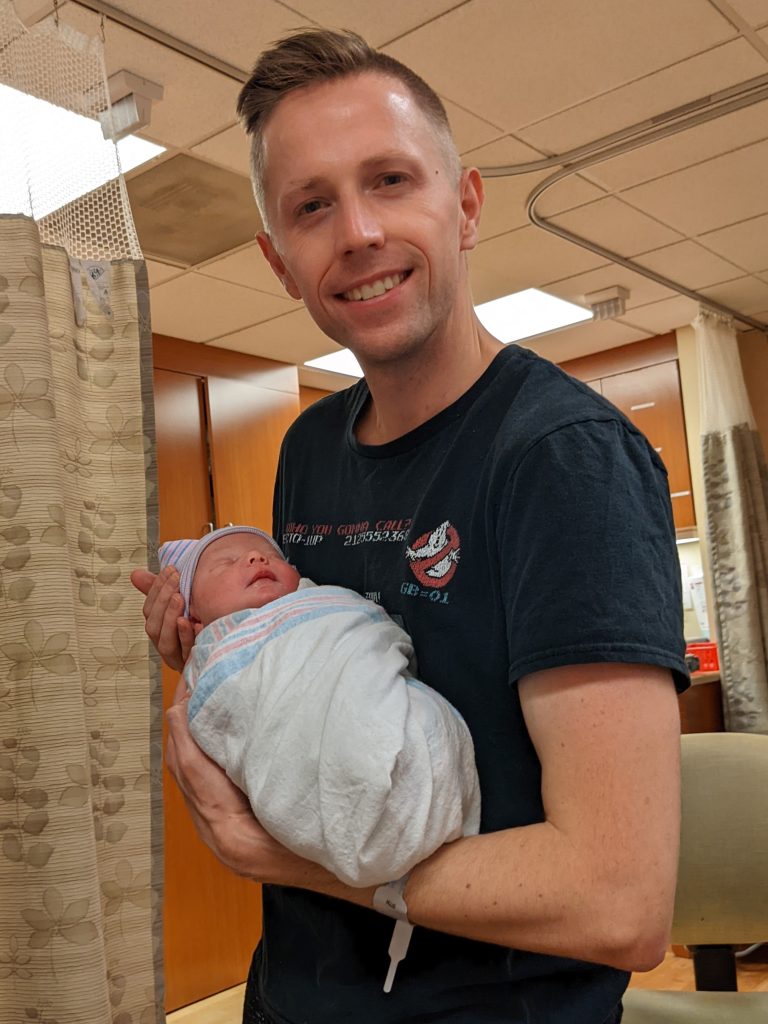
Though the short existence of CNN+ is a joke, it would be wrong to think that CNN+ simply failed as a product and that was why it ended. Early subscriber count leaks pegged the number at 150,000 after just 3 weeks, an incredibly positive figure that was above my own expectations. CNN+ was, first and foremost, the classic casualty of a media merger, with a takeover in management that simply did not want the product.
But CNN’s future was always streaming, and it is one they were destined to embrace. [Note: I originally started writing this in September of 2023, and this sentence was: “CNN’s future is streaming, and it is one they will embrace, sooner or later”]. In August of 2023, the company announced they would add CNN programming to Max, calling it CNN Max. This was followed by an announcement this month that the company would debut a new streaming service this fall.
Real life is sometimes beyond parody. But streaming makes sense for CNN, and it always did. However, there is one big opportunity that I wish other streaming services would have taken from CNN+.
Killing CNN+ Killed the Most Aggressive Interactive Community Experiment in Streaming, Even if it Wasn’t at All Revolutionary
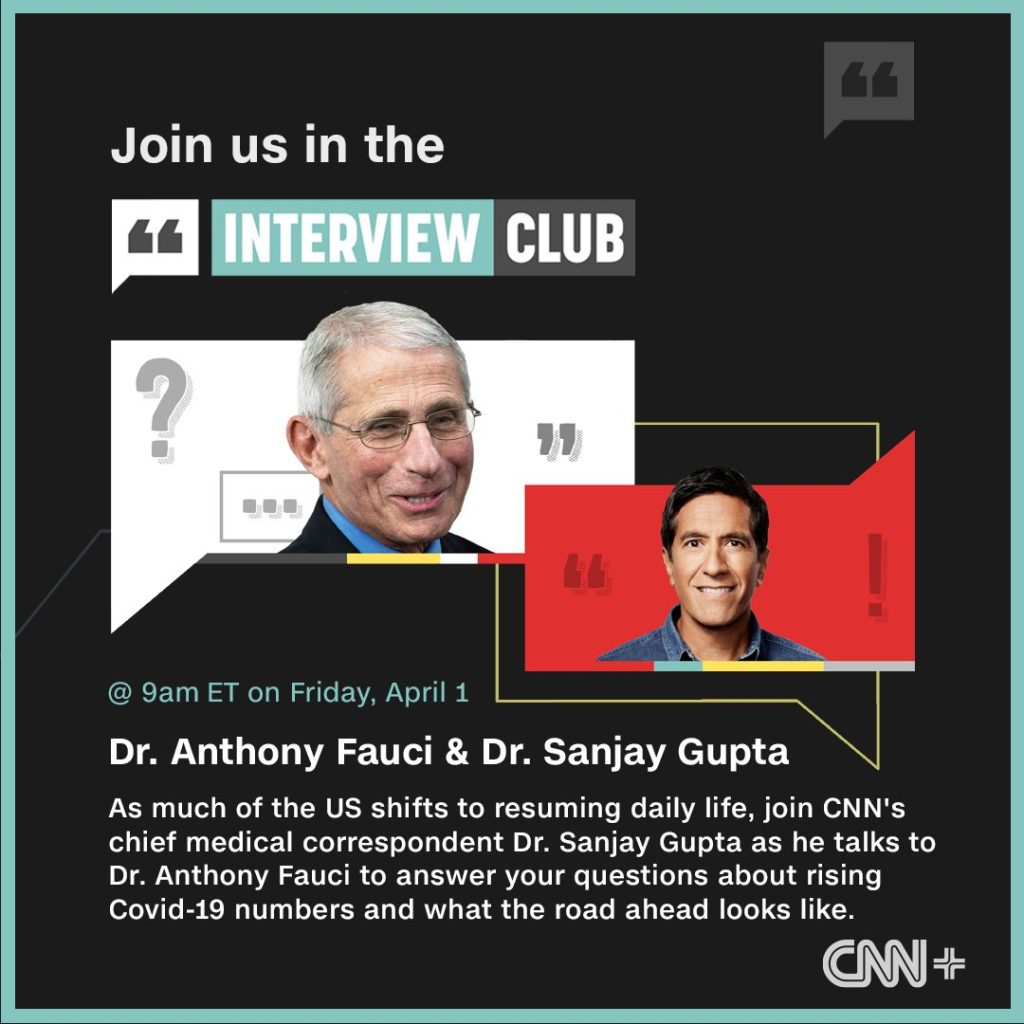
One of the three core pillars of CNN+ was interaction, alongside live programming and CNN’s on-demand library of content. This was first expressed through Interview Club, a live Q&A experience where a community of smart question askers would write and vote on questions that a CNN personality would then ask to a celebrity, newsmaker, or otherwise interesting person. My favorite example was Dr. Sanjay Gupta asking questions to Dr. Anthony Fauci.
It was designed to be the first of a portfolio of interactive experiences under the CNN+ banner. I always half-joked that I wanted to bring comments back to CNN.com – but only for CNN+ subscribers. But everyone always goes to comments when they talk about news media community. The opportunity was much bigger than that. Interview Club was not revolutionary. I was there when Yahoo! was hosting band chats in 1998.
But for both CNN and streaming services, it was aggressive. At launch, we were the only UGC (user-generated content) on CNN.com. They had long ago shipped interaction to third-party social platforms, where it is largely ignored. None of the big brand streaming services had anything like it – except for Netflix, who was experimenting with interactive movies and shows, like Black Mirror: Bandersnatch and Minecraft: Story Mode. Sadly, that experiment has come to an end. [Disclosure: My wife works at Netflix, though not on anything I’m discussing here].
Interview Club Was a Way to Turn “Customers” Into “Members”
The opportunity with Interview Club was a window into interactive experiences and measuring retention with regard to their usage. That is what I was always after: If you submitted and voted on questions for Interview Club – if you watched it – were you more likely to retain? To have a higher lifetime value as a customer? I suspect the answer would have been a resounding yes. But we’ll never know, because we weren’t allowed to reach renewal cycles.
The Interview Club model is one that most folks can follow and apply to their own products. As I said, it wasn’t revolutionary. It could have been run a lot more cheaply because our head count was needlessly high.
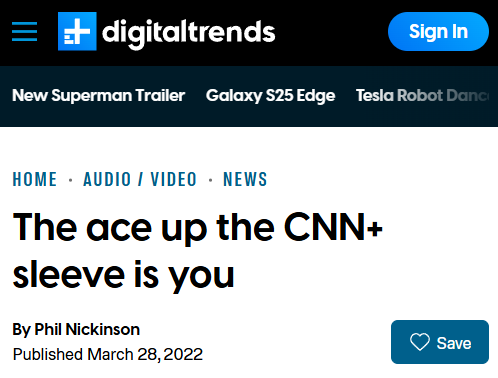
You have no reason to go back and read early reviews for CNN+, but if you did, you would find that one of the persistent bright spots was Interview Club. It was the differentiator. “[Interview Club] is a nifty feature that adds a welcome sense of community when most big broadcast news channels feel detached from their audiences,” wrote Jordan Minor for PCMag.
“Interview Club definitely is the sort of thing that keeps CNN+ from just being a news-centric streaming service,” added Phil Nickinson of DigitalTrends, even referencing Interview Club under the headline: “The ace up the CNN+ sleeve is you.”
The real disappointment from CNN+ is that those of us who worked on it never got to see the results play out. It very well could have failed. It also could have been successful. We’ll never know. But looking at the streaming landscape 3 years later, the popular services have not taken the lesson I hoped they would: Give your customers more to do than just watch.
Everyone wants to have the D2C (direct-to-consumer) retention business of The New York Times, but nobody wants to leave comments open for more than a decade, like they have, to build loyalty and increase retention.
Breaking Down the Experience: Before, During, and After
For each film, show, or other piece of content, I like to break the streaming experience into three stages. We are all in one of these three stages. They are:
- Before: They haven’t seen it yet! How do you interact with something you have yet to experience?
- During: They are watching it now! How do you interact with something as you are experiencing it?
- After: They watched it! How do they interact with something once they have completed it?
These three windows each create different opportunities for interaction. What someone will want to do will shift based upon where they sit in this lifecycle.
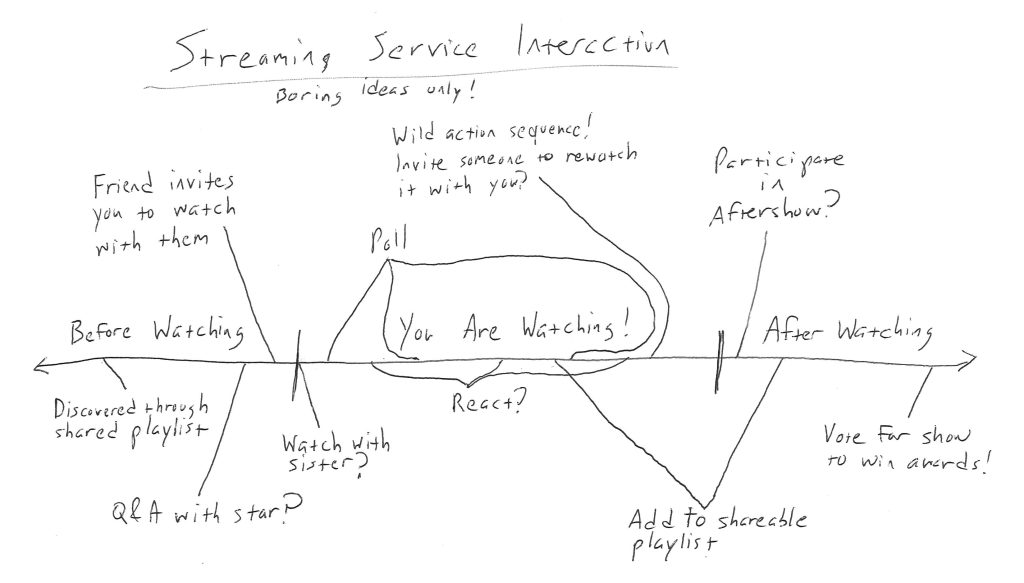
Boring, Familiar Ideas to Get You Started
People think about community or even generic interaction and immediately go to things like, “Do we need comments on everything?” or “We have to host forums now?” No, that’s not what I mean. People tend to view community as all-or-nothing. We either have to have an open text feed of rants on every single page of our product or we must have no interaction at all. That’s silly. The fun is in the middle.
Everything has a cost, however you quantify that. People cost, tech debt, engineering resources. It’s easy to dismiss an idea under the guise of it supposedly not being realistic because the person suggesting them doesn’t have a practical grasp on the resources required. That’s not me. I’ve been there, and I sympathize, but I also believe it is worth investing in community-minded features.
Ideas are cheap, and execution is what matters.
Here are a few ideas that can serve as a starting point. They’ll seem boring. There is no magic here. But I’m not trying to launch something that has never been done before. You need to first travel down familiar in-roads to bring people in deeper, to build stronger loyalty as opposed to passive consumption. You then need to measure your success and the value to the business. And then you can go wild and do things that are really unique.
View each through this context: Right now, big brand streaming services give subscribers virtually nothing to do except search and watch. Any movement toward greater interaction is a big step. Start small.
Live Q&A aftershows and programs on your service with your talent and questions submitted via your app. I repeat: Via your app. This is Interview Club. Shows like Talking Dead, Talking Bad, and Watch What Happens Live with Andy Cohen have existed for a long time. But as a streaming service, you need to take questions via your paid experience! Not a phone number and definitely not Twitter.
I don’t think most folks should even be on Twitter at this point, but even if I didn’t feel that way: Your existence as a streaming service on Twitter (or any social network) is to use Twitter to drive people to you. Not to drive people to Twitter.
Why are we not incentivizing subscribers by only taking questions from them? Let them vote on questions. Pick the popular ones. Pick the tough ones! And then tell everyone who voted that The Rock answered their question, with an easy way to find the answer.

You can do it on a budget. Find a good host (note: a good host and a famous host are not the same thing) and book great guests from your talent working on the films, series, and specials that you are releasing on your service. Yes, this will promote those new releases to your subscribers. But to be great, here’s the not-so-secret: The questions must be real, and they must be good.
Assume that people will clip answers and beat them to it! Offer shareable clips via social emphasizing the value of watching live in the moment and the ability to actually participate. Both of which only subscribers can do.
Polls (especially before or as things happen). The simplest thing of all. So simple, no one even thinks about them any longer. When someone is watching an episode of a particularly dramatic show, what if they could vote about what might happen next or how they feel about something? And see how others voted when they were at the same point in that show?
“I don’t want that!,” many will say. “That’s distracting!” But that’s why it’s opt-in. For some, it’ll be a fun way to stay engaged, while simultaneously creating interesting content for your editorial, email, and social teams. “Before watching Jimmy choose Veronica, 56% of viewers thought he would…” Promotion via those channels will drive adoption of the feature. Do customers who vote in polls retain at a higher rate? You might be surprised.

Shareable playlists. It makes a ton of sense not to host reviews. That would create an awkward can of worms. But playlists are a different matter. Most platforms have their own official, curated playlists, whether by algorithm or human. IMDb, Letterboxd, and numerous movie communities and social networks have their own list features.
So then, why make your own? Because people use them. People love cataloging films, series, and specials. They love recommending them.
A big difference? The lists on your service will only recommend what you have on your service. To limit moderation, trust, and safety issues, you can allow people to input text only in the title. Automated filtering can knock down the most common issues. Concerned about them dominating Google results? Block them from being indexed. You can make it a strictly word-of-mouth thing, and people will use it.
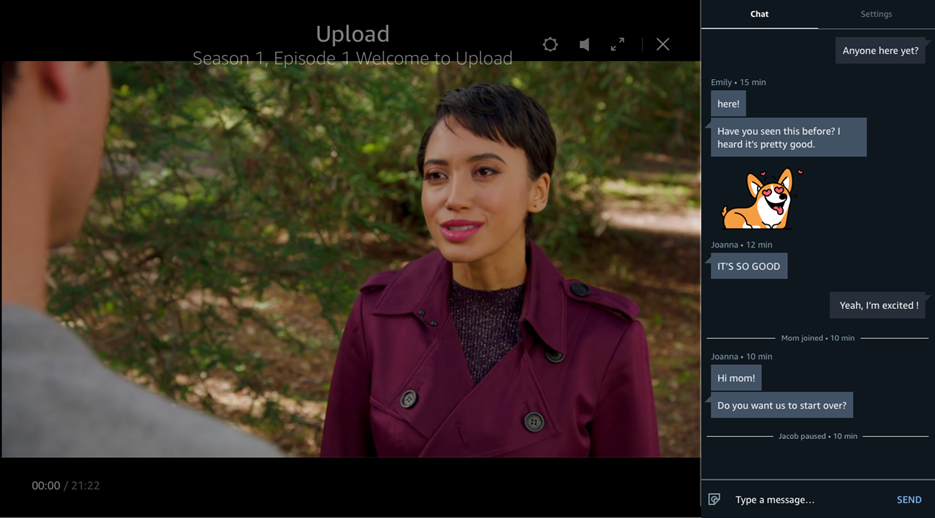
Critics and reviewers will use it to showcase the releases they liked (or didn’t). Directors, actors, writers, crew, and similar folks will use it to share what they’ve worked on. Watchers will use it … in every which way, really. Favorite films, shows with talking cars, films made in 1933, whatever. There are smart ways to allow people to follow or subscribe to lists without it ever entering the home screen or intruding upon your most valuable real estate. It can be buried in the menu and still generate a lot of attention.
Watch with others. Most streaming services farm this out to Teleparty, in the sense that they know it exists and are okay with it. Watching together requires all participants to be paying customers, so it makes perfect sense. But Teleparty only works in the Chrome, Microsoft Edge, Opera, and Safari web browsers, and on Android devices. I have a Roku. When I watch something with my brother, we just try our best to sync up and run a Discord call.
Prime Video used to have a Watch Party feature, but they removed it last year. In not offering it natively, streaming services are missing out on data and lacking the ability to build out the experience further, while they are at the same time cracking down on shared passwords.
If something you saw amazed you – or triggered another emotion – what if you could invite your sister to rewatch that part with you instantly? “You’ve got to see this!”
Live programming adds a layer to this. One idea we were kicking around at CNN, where Interview Club was live behind a paywall, was how we could permit multiple subscribers to all watch at the same time, and have mini chat or interactive experiences amongst themselves. For example, what if they could see the questions that they had submitted or voted on as a group?

Choose your own adventure. The aforementioned interactive stories from Netflix were an interesting experiment. Interactive storytelling can be a lot of fun, either as an entire program or only as an episode or a bonus. People made entire decision flowcharts for Bandersnatch.
Streaming services should have their own viewer awards. Every streaming service should host its own yearly viewer and/or fan awards program. Who’s allowed to vote? Subscribers only, of course! Via your own platforms, of course!
Come up with interesting and fun categories. Have a virtual ceremony with a host from your talent pool. Hand out awards! Let winners talk about how much they care about the fans. It is a lot of fun, and it’s a great way to get fans talking about your service, because they will become advocates for their favorites to win.
Reactions (More Than Just “Like” or “Love”). Allow people to pick from a set of interactions to express what they are feeling as they watch. Once they pick, you can then surface how others were feeling, too. Come up with a broad mix of reactions – including something that’ll be unique to your platform.
This could also be more fun content for editorial, email, and social to use to talk about specific shows and how people felt before or after particularly big moments. Which will drive more people to use the feature.
Just like polling, this would be an opt-in type of feature.
I can’t say enough how the ideas above are just seeds to get people thinking. They aren’t earth-shattering. You have to walk before you can run. I suspect some will be tempted to offer anecdotes like, “well, we tried this one, and we didn’t see anything good from it” or “I worked at Amazon on Watch Party, and no one used it!” While that could represent an insightful comment, there are some variables.
Different companies – even different streaming services – might see variations in the type of customers they attract. The market might be different. And again, ideas are cheap, and execution is what matters. Your mix of conviction, executive support, promotion, and talent will have the greatest impact on your success.
Social Connection Features Layer on Top of All of This
One of the fun things you can do, once you start to build out features like this, is you can make it possible for people to see how their friends are participating, too.
- What questions are my friends asking at live events?
- How did my friends react while watching Love Is Blind during that moment?
- How did my friends vote in that poll?
You can add an additional level of connectiveness to all of these things, simply by allowing people to have the most basic level of interaction with the folks they care about. And you can do it without social feeds, direct messages, or any of that truly messy stuff!
This will also give them even more reason to stay subscribed. What is the retention rate for a subscriber that watches a particular show, reacts to it during the show, and has friends who also reacted? Wouldn’t that be fun to know? Which leads us to…
Measuring the Financial Impact
The primary business goal of these programs is to increase retention, which increases revenue. You are trying to cultivate deeper relationships with customers, to turn them into dedicated members, and measure what that means to your bottom line.
You can do that per feature or per group of features. You might find that one thing you try works, while another doesn’t. The fact that streaming services own a lot of customer data provides them with a greater ability to do this than many other corporations.
Beyond that, it’s about increasing the lifetime value of your customers. How does a member who uses an interactive feature compare to one who doesn’t? How much money do they give you? How much merch do they buy? How likely are they to retain? To attend an event? How do their hours on your service compare?
You follow the data where it leads, and adjust from there. It could lead you to find that interactive and community-minded features actually aren’t worth the investment at all. But more than likely, it’ll send you in a different direction.
When I was building a subscription product for a mainstream media brand, we found that members who participated in our private online community, beyond saying hello, were 18.46% more likely to retain than members who didn’t participate at all. What would an 18.46% increase in retention mean for you?
